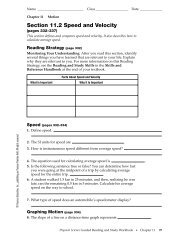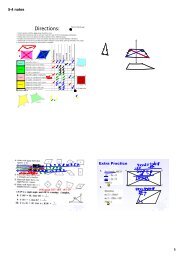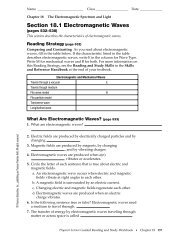Section 4.1 Studying Atoms - Barrington High School
Section 4.1 Studying Atoms - Barrington High School
Section 4.1 Studying Atoms - Barrington High School
Create successful ePaper yourself
Turn your PDF publications into a flip-book with our unique Google optimized e-Paper software.
Name ___________________________ Class ___________________ Date _____________<br />
Chapter 4<br />
Atomic Structure<br />
<strong>Section</strong> <strong>4.1</strong> <strong>Studying</strong> <strong>Atoms</strong><br />
(pages 100-105)<br />
This section discusses the development of atomic models.<br />
Reading Strategy (page 100)<br />
Summarizing As you read, complete the table about atomic models.<br />
For more information on this Reading Strategy, see the Reading and<br />
Study Skills in the Skills and Reference Handbook at the end of<br />
your textbook.<br />
Atomic Models<br />
Scientist Evidence Model<br />
Ratio of masses<br />
in compounds<br />
Deflected beam<br />
Rutherford<br />
Positive, dense nucleus<br />
© Pearson Education, Inc., publishing as Pearson Prentice Hall. All rights reserved.<br />
Ancient Greek Models of <strong>Atoms</strong> (page 100)<br />
1. Democritus named the smallest particles of matter<br />
because they could not be divided.<br />
2. List the four elements that Aristotle included in his model of matter.<br />
a. b.<br />
c. Fire<br />
d.<br />
Water<br />
Dalton’s Atomic Theory (page 101)<br />
3. Is the following sentence true or false? John Dalton gathered<br />
evidence for the existence of atoms by measuring the masses of<br />
elements that reacted to form compounds.<br />
true<br />
4. What theory did Dalton propose to explain why the elements<br />
in a compound always join in the same way?<br />
5. Circle the letters of the sentences that represent the main points of<br />
Dalton’s theory of atoms.<br />
a. All elements are composed of atoms.<br />
b. In a particular compound, atoms of different elements always<br />
combine the same way.<br />
c. All atoms have the same mass.<br />
d. Compounds contain atoms of more than one element.<br />
Physical Science Guided Reading and Study Workbook ■ Chapter 4 27
Name ___________________________ Class ___________________ Date _____________<br />
Chapter 4<br />
Atomic Structure<br />
Thomson’s Model of the Atom (pages 102–103)<br />
6. Objects with like electric charges , and objects with<br />
opposite electric charges .<br />
7. What happened to the beam when Thomson placed a pair of charged metal plates<br />
on either side of the glass tube?<br />
8. Thomson concluded that the particles in the glowing beam had a(n)<br />
charge because they were attracted to a positive plate.<br />
9. Is the following sentence true or false? Thomson’s experiments<br />
provided the first evidence for the existence of subatomic particles.<br />
10. Describe Thomson’s model.<br />
Rutherford’s Atomic Theory (pages 104–105)<br />
11. What is an alpha particle?<br />
12. Fill in the table to show what Rutherford hypothesized would<br />
happen to the paths of alpha particles as they passed through a<br />
thin sheet of gold.<br />
Rutherford’s Hypothesis<br />
Most particles would travel<br />
from their source to a screen that lit up<br />
when struck.<br />
Particles that did not pass straight<br />
through would be<br />
13. Circle the letters of the sentences that describe what happened<br />
when Marsden directed a beam of particles at a piece of gold foil.<br />
a. Fewer alpha particles were deflected than expected.<br />
b. More alpha particles were deflected than expected.<br />
c. None of the alpha particles were deflected.<br />
d. Some alpha particles bounced back toward the source.<br />
14. Circle the letter of the sentence that states what Rutherford<br />
concluded from the gold foil experiment.<br />
a. An atom’s negative charge is concentrated in its nucleus.<br />
b. Thomson’s model of the atom was correct.<br />
c. An atom’s positive charge is concentrated in its nucleus.<br />
d. An atom’s positive charge is spread evenly throughout<br />
the atom.<br />
© Pearson Education, Inc., publishing as Pearson Prentice Hall. All rights reserved.<br />
28 Physical Science Guided Reading and Study Workbook ■ Chapter 4


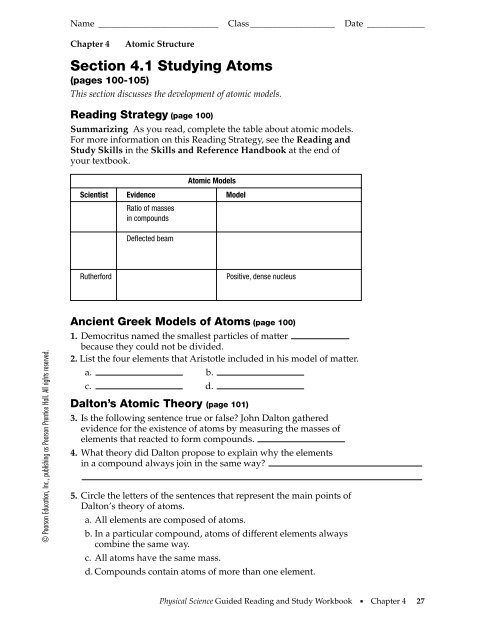

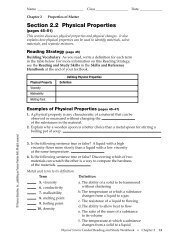
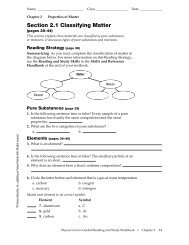

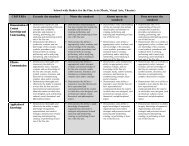
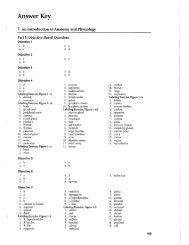
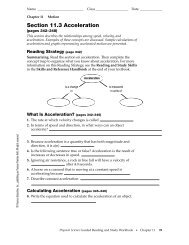
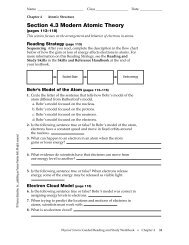
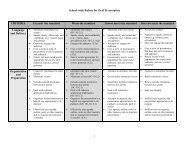
![Nov1-3 [Laurie Garland] - The Charles A. Dana Center](https://img.yumpu.com/26208999/1/190x146/nov1-3-laurie-garland-the-charles-a-dana-center.jpg?quality=85)

